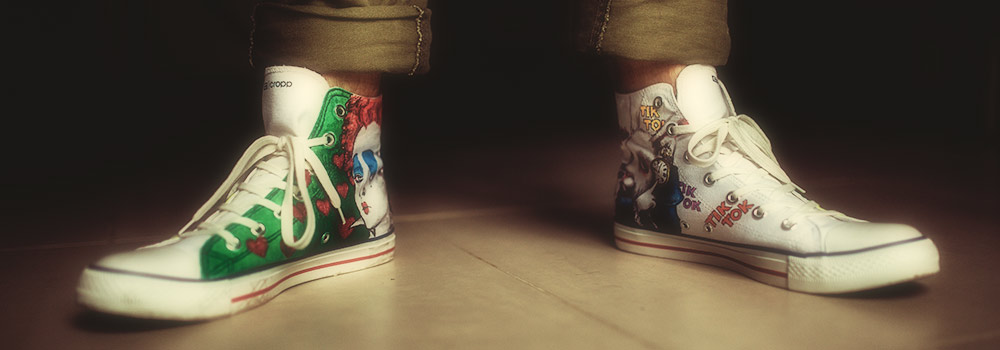
If you’re selling something that, upon first glance, either looks the same as what others are selling or has a significant price difference to whatever else is out there; you need to get your ‘story’ straight. Let me explain.
If you’re a regular reader here, then (firstly) thanks for being here.
Secondly, you may remember me mentioning that I’m a bit of a hi-fi nut.
I enjoy listening to music. No, I mean really enjoy listening to music. I like to hear all the the nuances of a recording. The pluck and subsequent decay of a guitar string. The subtleties in inflection of a singer’s voice.
A well-recorded, mixed and produced piece of music considerably enhances my enjoyment of it. Over the years, in order to maximize the ‘clarity’ of reproduction, I have invested in a hi-fi system that can deliver the goods.
That means never listening to MP3 files if I can help it. It means downloading high-definition audio tracks from places such as linnrecords.com or hdtracks.com rather than settling with CDs. It means adding weird and wonderful pieces of equipment to my rig such as DACs, headphone amplifiers, power conditioners and high-quality interconnects.
What a geek, right?
Talking in stories, not in jargon
Buying esoteric audio equipment from companies such as Linn, Naim or Bowers & Wilkins, there’s a common link in the way that they all talk about their philosophy and products.They all talk in terms of stories. They create a narrative.
They don’t talk about the ‘scientific’ credentials of their equipment. How accurate the output is compared to the input. There are no graphs or tables. No jargon, or measurements in hertz, watts, or percentages.
It’s not about quantitative measurements. It’s about something else. Often, it’s about what I started talking about at the beginning of this piece: An individual’s enjoyment of music.
They realize that talking about the ‘facts’ of their proposition effectively reduces their product’s value to a set of numbers that – on the face of it at least – the competition could emulate.
Instead they talk about how a quality music system enhances listening pleasure by enhancing the way that you ‘feel’ about what you’re listening to.
They don’t talk about bass and treble, but how voices and instruments sound more lifelike. They’ll talk about intangibles, emotions and feelings that resonate with their target audience.
Facts tell, stories sell
Of course it’s not just hi-fi manufacturers that do this.Take mobile phones as another example. Manufacturers such as Samsung, LG or HTC wax lyrical about their high-resolution screens, or how much RAM is inside, or what processor they use.
Apple, in contrast, talk about how easy is it to talk to your loved ones on video chat. Or how having a camera in your phone allows you to easily share the important, transient moments of your life with friends or family.
Your story is your differentiation
Hopefully, whatever you’re selling to your target market is somehow different to what your competition is selling. Maybe the differentiation is price (though hopefully not just price). Maybe it’s features. Maybe it’s quality. Maybe it’s service.Whatever it is,there’s clearly a reason as to why you’re doing what you’re doing. You have a passion to sell whatever you’re selling because of a story, a reason, a narrative. Ultimately, it’s the reason that you’re in business.
The thing is, it’s also the reason why people who believe in what you’re doing will buy from you. They just need to know your story.
It’s not about democratising a value offering to its lowest common denominator, in order to appeal to the broadest audience possible. That’s what the big guys do and – no matter what you think – their limitless budgets, resources and aggressive sales and marketing tactics means that going up against them means that you will fail.
What you have on your side is your narrative. Your story. Your raison d’être.
The King’s New Clothes
I should clarify one thing, however. By communicating your “story” I don’t mean one that you’ve invented because it sounds nice.The story that you tell needs to be seen as real, authentic and confirmed in the minds of your audience by what you’re seen to be doing, acting and communicating. As consumers, our “BS Radar” has become extremely acute over the recent years. We’ve learned to spot a fake in a heartbeat.
It’s not about putting a spin on the story of the King’s New Clothes and trying to fool or hoodwink your audience into believing something. You can fool some of the people some of the time, but – just as in the story of The King’s New Clothes – there’s always going to be that kid in the crowd that’ll call you out.
Tell your story. Your customers want to hear it
People buy stories. They buy experiences, feelings and emotions. They buy from companies and individuals that they feel have similar positions, thoughts and ideals to their own.Don’t be afraid to tell your story. Tell it from your point-of-view. Tell it from your heart, in your own words. Say it in places where your audience congregates, and your customers, fans (and evangelists) will come.
Recent articles:
Dark Social: The Hidden Conversations Marketers Can’t See

Marketing In A Recession: How To Weather The Storm

How To Convince A Marketing Skeptic

Privacy Protection: Why Ad Tracking Must End

Marketing Isn’t About Being Brave: It’s About Being Effective

Why Seeking Consensus Prevents Business Innovation

